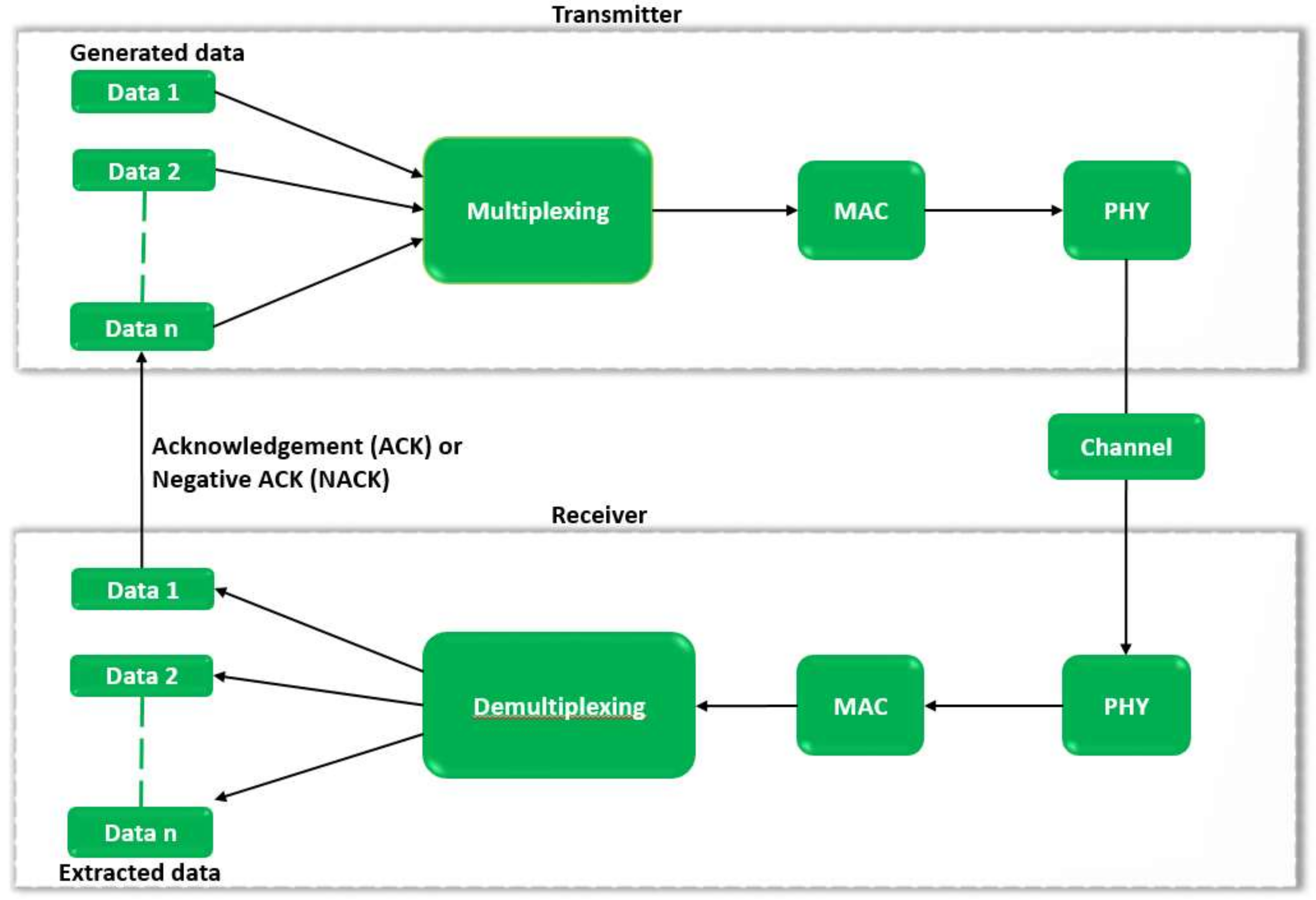Opportunities and Challenges for Error Correction Scheme for Wireless Body Area Network—A Survey
Abstract
:1. Introduction
2. Error Correction Scheme (ECS)
2.1. Automatic Repeat Request (ARQ)
2.2. Forward Error Correction (FEC)
2.3. Hybrid Automatic Repeat Request (HARQ)
2.4. Modulation
3. IEEE 802.15.6 WBAN Standard
4. Channel and Network Models
5. Review on ECS Methods on WBAN
5.1. Forward Error Correction (FEC)
5.2. HARQ
5.2.1. HARQ-I
5.2.2. HARQ-II
5.3. Modulation
6. Future Research Challenges and Opportunities
- The overall efficiency of ECS for WBAN depends on interferences from other WBANs and other existing systems, such as Wi-Fi and WLAN. Further research is expected to analyse the efficiency of WBAN in practical and real-life settings rather than isolated settings, as considered in previous research works.
- A very limited research work is conducted when considering two hop WBAN. One open area of the research is to analyse the consequence, significance, and complication on ECS design when considering two hop in WBAN.
- Does treating the forward link (for example, implant node to surface node) and reverse link (for example, surface node to implant node) differently (similar to mobile communication uplink and downlink) facilitate the innovative design of ECS of WBAN?
- Most of the proposed ECS designs are based on RF communication channels. Does the HBC technique improve or aid on design of efficient ECS for WBAN? This research area, however, significantly differs from the ECS design that we discussed in this paper.
- Most of proposed research works on ECS design for WBAN are based on RF communication channels. Is the optical communication technique, as discussed in [65], appropriate to improve or aid in design of efficient ECS for WBAN specifically implant to implant and implant to wearable device? This research area, however, significantly differs from the ECS design that we discussed in this paper.
- One of the greatest challenges in ECS design on WBAN is to verify the design and expected outcome. Therefore, the creation of simulation settings or tools that resembles the real human bodies is another challenge and would be another research area to explore.
7. Conclusions
Author Contributions
Funding
Conflicts of Interest
Appendix A
| Acronyms | Definitions | Acronyms | Definitions |
|---|---|---|---|
| ACK | Acknowledgement | MAC | Media Access |
| ADS | Advanced Design System | MAE | Mean Absolute Error |
| ARQ | Automatic Repeat Request | MAP | Maximum a Posteriori |
| AWGN | Additive White Gaussian Noise | MICS | Medical Implant Communication Service |
| 2PPM | Binary Pulse Position Modulation | ML | Maximum Likelihood |
| BCH | Bose-Chaudhuri-Hocquenghem | NACK | Negative Acknowledgement |
| BER | Bit Error Rate | NB | Narrow Band |
| BMP | Binary Message Passing | NLOS | Non Line Of Sight |
| BP | Belief Propagation | O-QPSK | Offset Quadrature Phase Shift Keying |
| CM | Channel Model | OSI | Open System Interconnection |
| CRC | Cyclic Redundancy Check | PCCC | Parallel-Concatenated Convolutional Code |
| D8PSK | Differential 8-Phase Shift Keying | PAR | Packet Acceptance Rate |
| DBPSK | Differential Binary Phase Shift Keying | PER | Packet Error Rate |
| DQPSK | Differential Quadrature Phase Shift Keying | PHY | Physical |
| ECC | Error-Correction Code | QoS | Quality of Service |
| ECS | Error Correction Scheme | RA | Repeat Accumulate |
| EFC | Electric Field Communication | RF | Radio Frequency |
| FEC | Forward Error Correction | RS | Reed-Solomon |
| FM | Frequency Modulation | RSS | Received Signal Strength |
| GMSK | Gaussian Minimum Shift Keying | SPA | Sum-Product Algorithm |
| HARQ | Hybrid Automatic Repeat Request | SNR | Signal to Noise Ratio |
| HBC | Human Body Communication | SIR | Signal to Interference Ratio |
| IR | Impulse Radio | UMTS | Universal Mobile Telecommunication System |
| LDPC | Low-Density Parity Check | UWB | Ultra-Wide Band |
| LOS | Line Of Sight | WBAN | Wireless Body Area Network |
| LT | Luby Transform | WBF | Weighted Bit Flipping |
References
- Ullah, S.; Higgins, H.; Braem, B.; Latre, B.; Blondia, C.; Moerman, I.; Saleem, S.; Rahman, Z.; Kwak, K.S. A comprehensive survey of wireless body area networks. J. Med. Syst. 2012, 36, 1065–1094. [Google Scholar] [CrossRef] [PubMed]
- Jovanov, E.; Milenkovic, A.; Otto, C.; de Groen, P.C. A wireless body area network of intelligent motion sensors for computer assisted physical rehabilitation. J. NeuroEng. Rehabil. 2005, 2, 6. [Google Scholar] [CrossRef] [PubMed]
- Ullah, S.; Khan, P.; Ullah, N.; Saleem, S.; Higgins, H.; Kwak, K.S. A Review of Wireless Body Area Networks for Medical Applications. arXiv, 2010; arXiv:1001.0831. [Google Scholar] [CrossRef]
- Movassaghi, S.; Abolhasan, M.; Lipman, J.; Smith, D.; Jamalipour, A. Wireless body area networks: A survey. IEEE Commun. Surv. Tutor. 2014, 16, 1658–1686. [Google Scholar] [CrossRef]
- Rangarajan, A. Emerging trends in healthcare adoption of wireless body area networks. Biomed. Instrum. Technol. 2016, 50, 264–276. [Google Scholar] [CrossRef] [PubMed]
- Crosby, G.V.; Ghosh, T.; Murimi, R.; Chin, C.A. Wireless body area networks for healthcare: A survey. Int. J. Ad Hoc Sens. Ubiquitous Comput. 2012, 3, 1. [Google Scholar] [CrossRef]
- Barakah, D.M.; Ammad-uddin, M. A survey of challenges and applications of wireless body area network (WBAN) and role of a virtual doctor server in existing architecture. In Proceedings of the 2012 Third International Conference on Intelligent Systems, Modelling and Simulation (ISMS), Kota Kinabalu, Malaysia, 8–10 February 2012; pp. 214–219. [Google Scholar]
- Peterson, L.L.; Davie, B.S. Computer Networks: A Systems Approach; Elsevier: Amsterdam, The Netherlands, 2007. [Google Scholar]
- Wang, C.; Sklar, D.; Johnson, D. Forward error-correction coding. Crosslink 2001, 3, 26–29. [Google Scholar]
- Wicker, S.B. Error Control Systems for Digital Communication and Storage; Prentice Hall: Englewood Cliffs, NJ, USA, 1995; Volume 1. [Google Scholar]
- Proakis, J. Digital Communications, 4th ed.; McGraw-Hill Google Scholar: New York, NY, USA, 2001. [Google Scholar]
- Costello, D.J. Error Control Coding: Fundamentals and Applications; Prentice Hall: Englewood Cliffs, NJ, USA, 1983. [Google Scholar]
- Howard, S.L.; Schlegel, C.; Iniewski, K. Error control coding in low-power wireless sensor networks: When is ECC energy-efficient? EURASIP J. Wirel. Commun. Netw. 2006, 2006, 074812. [Google Scholar] [CrossRef]
- Hamming, R.W. Error detecting and error correcting codes. Bell Labs Tech. J. 1950, 29, 147–160. [Google Scholar] [CrossRef]
- Gallager, R. Low-density parity-check codes. IRE Trans. Inf. Theory 1962, 8, 21–28. [Google Scholar] [CrossRef] [Green Version]
- Divsalar, D.; Jin, H.; McEliece, R.J. Coding theorems for “turbo-like” codes. In Proceedings of the 36th Annual Allerton Conference on Communication Control and Computing, Monticello, IL, USA, 23–25 September 1998; pp. 201–210. [Google Scholar]
- Hocquenghem, A. Codes correcteurs d’erreurs. Chiffres 1959, 2, 147–156. [Google Scholar]
- Bose, R.C.; Ray-Chaudhuri, D.K. On a class of error correcting binary group codes. Inf. Control 1960, 3, 68–79. [Google Scholar] [CrossRef]
- Reed, I.S.; Solomon, G. Polynomial codes over certain finite fields. J. Soc. Ind. Appl. Math. 1960, 8, 300–304. [Google Scholar] [CrossRef]
- Benedetto, S.; Montorsi, G. Design of parallel concatenated convolutional codes. IEEE Trans. Commun. 1996, 44, 591–600. [Google Scholar] [CrossRef]
- Berrou, C.; Glavieux, A.; Thitimajshima, P. Near Shannon limit error-correcting coding and decoding: Turbo-codes. Proceedings of ICC ’93—IEEE International Conference on Communications, Geneva, Switzerland, 23–26 May 1993; pp. 1064–1070. [Google Scholar]
- Beutelspacher, A.; Rosenbaum, U. Projective Geometry: From Foundations to Applications; Cambridge University Press: Cambridge, UK, 1998. [Google Scholar]
- Feldman, J.; Wainwright, M.J.; Karger, D.R. Using linear programming to decode binary linear codes. IEEE Trans. Inf. Theory 2005, 51, 954–972. [Google Scholar] [CrossRef]
- Viterbi, A. Error bounds for convolutional codes and an asymptotically optimum decoding algorithm. IEEE Trans. Inf. Theory 1967, 13, 260–269. [Google Scholar] [CrossRef]
- Bahl, L.; Cocke, J.; Jelinek, F.; Raviv, J. Optimal decoding of linear codes for minimizing symbol error rate (corresp.). IEEE Trans. Inf. Theory 1974, 20, 284–287. [Google Scholar] [CrossRef]
- Pearl, J. Probabilistic Reasoning in Intelligent Systems: Networks of Plausible Inference; Morgan Kaufmann: Burlington, MA, USA, 2014. [Google Scholar]
- Wiberg, N. Codes and Decoding on General Graphs; Linköping University: Linköping, Sweden, 1996. [Google Scholar]
- Comroe, R.; Costello, D. ARQ schemes for data transmission in mobile radio systems. IEEE J. Select. Areas Commun. 1984, 2, 472–481. [Google Scholar] [CrossRef]
- Proakis, J.; Salehi, M.; Bauch, G. Contemporary Communication Systems Using MATLAB; Nelson Education: Scarborough, ON, Canada, 2012. [Google Scholar]
- IEEE 802.15.6-2012. IEEE Standard for Local and Metropolitan Area Networks—Part 15.6: Wireless Body Area Networks; IEEE: New York, NY, USA, 2012. [Google Scholar]
- Ullah, S.; Mohaisen, M.; Alnuem, M.A. A review of IEEE 802.15. 6 MAC, PHY, and security specifications. Int. J. Distrib. Sens. Netw. 2013, 9, 950704. [Google Scholar] [CrossRef]
- Yazdandoost, K.; Sayrafian, K. Channel Model for Body Area Network (BAN); IEEE: Piscataway, NJ, USA, 2010. [Google Scholar]
- Takizawa, K.; Hamaguchi, K. Design of packet erasure mitigation technique using a digital fountain code for wearable wireless body area networks. In Proceedings of the 2010 Annual International Conference of the Engineering in Medicine and Biology Society (EMBC), Buenos Aires, Argentina, 31 August–4 September 2010; pp. 356–359. [Google Scholar]
- Hamada, Y.; Takizawa, K.; Ikegami, T. Highly reliable wireless body area network using error correcting codes. In Proceedings of the Radio and Wireless Symposium (RWS), Santa Clara, CA, USA, 15–18 January 2012; pp. 231–234. [Google Scholar]
- Goto, T.; Takabayashi, K.; Kohno, R. An adaptive error control scheme considering various channel conditions and QoS in medical and non-medical data for WBAN. In Proceedings of the 2016 10th International Symposium on Medical Information and Communication Technology (ISMICT), Worcester, MA, USA, 20–23 March 2016; pp. 1–3. [Google Scholar]
- Deepak, K.; Babu, A. Performance Evaluation of Forward Error Correction Schemes in Wireless Body Area Networks. In Intelligent Computing and Applications; Springer: New Delhi, India, 2015; pp. 469–478. [Google Scholar]
- Khattiya, W.; Timakul, S.; Choomchuay, S. An error control coding in MAC layer for UWB WBAN. In Proceedings of the 2013 IEEE International Conference on Signal Processing, Communication and Computing (ICSPCC), KunMing, China, 5–8 August 2013; pp. 1–5. [Google Scholar]
- Takizawa, K.; Watanabe, K.; Kumazawa, M.; Hamada, Y.; Ikegami, T.; Hamaguchi, K. Performance evaluation of wearable wireless body area networks during walking motions in 444.5 MHz and 2450 MHz. In Proceedings of the 2010 Annual International Conference of the Engineering in Medicine and Biology Society (EMBC), Buenos Aires, Argentina, 31 August–4 September 2010; pp. 370–373. [Google Scholar]
- Praveena, V.; Kaythry, P.; Kishore, R. Fountain code based error control technique in wireless body area network. In Proceedings of the Wireless Communications, Signal Processing and Networking (WiSPNET), Chennai, India, 22–24 March 2017; pp. 430–434. [Google Scholar]
- Kaythry, P.; Kishore, R.; Praveena, V. Energy Efficient Raptor Codes for Error Control in Wireless Body Area Networks. Wirel. Pers. Commun. 2018, 103, 1–19. [Google Scholar] [CrossRef]
- Boussaid, A.; Alaoui, N.; Aghzout, O.; Chakkour, Y.; Alejos, A.V.; Falcone, F. Highly efficient error correcting codes for ubiquitous healthcare in Wireless Body Area Networks. In Proceedings of the 2016 International Conference on Electrical and Information Technologies (ICEIT), Tangiers, Morocco, 4–7 May 2016; pp. 225–230. [Google Scholar]
- Youssef, A.A.; Abdelhamid, B.; El-Ramly, S.H.; Elattar, H.M.; Ali, H.H. LDPC Decoding Algorithms for Implant to Implant Wireless Body Area Network. IEEE Access 2018, 6, 13200–13212. [Google Scholar] [CrossRef]
- Ahmed, E.; Kohno, R. Error control coding and decoding with medical QoS constraints for WBAN end to end connection via UMTS channel. ICT Express 2018, 4, 181–185. [Google Scholar] [CrossRef]
- Reusens, E.; Joseph, W.; Latré, B.; Braem, B.; Vermeeren, G.; Tanghe, E.; Martens, L.; Moerman, I.; Blondia, C. Characterization of on-body communication channel and energy efficient topology design for wireless body area networks. IEEE Trans. Inf. Technol. Biomed. 2009, 13, 933–945. [Google Scholar] [CrossRef] [PubMed]
- Fort, A.; Ryckaert, J.; Desset, C.; de Doncker, P.; Wambacq, P.; van Biesen, L. Ultra-wideband channel model for communication around the human body. IEEE J. Select. Areas Commun. 2006, 24, 927–933. [Google Scholar] [CrossRef]
- Futatsugi, T.; Sugimoto, C.; Kohno, R. A study on HARQ error-controlling scheme for the wireless control of medical equipment. In Proceedings of the 2012 6th International Symposium on Medical Information and Communication Technology (ISMICT), La Jolla, CA, USA, 25–29 March 2012; pp. 1–4. [Google Scholar]
- Liu, W.; Yang, Y.; Wang, F.; Wang, E. Error control strategy in ultrasonic Body Area Networks. China Commun. 2016, 13, 244–259. [Google Scholar]
- Suzuki, H.; Kohno, R. Performance analysis of hybrid ARQ error-controlling scheme for UWB BAN. In Proceedings of the 2011 5th International Symposium on Medical Information & Communication Technology (ISMICT), Montreux, Switzerland, 27–30 March 2011; pp. 94–97. [Google Scholar]
- Takabayashi, K.; Tanaka, H.; Sugimoto, C.; Kohno, R. An error control scheme with Weldon’s ARQ considering various QoS in medical and non-medical uses for wireless BANs. In Proceedings of the 2013 7th International Symposium on Medical Information and Communication Technology (ISMICT), Tokyo, Japan, 6–8 March 2013; pp. 47–51. [Google Scholar]
- Takabayashi, K.; Tanaka, H.; Sugimoto, C.; Kohno, R. Multiplexing and error control scheme with modified hybrid ARQ for body area network employing IEEE 802.15. 6 in UWB-PHY. In Proceedings of the 8th International Conference on Body Area Networks, Boston, MA, USA, 30 Sptember–2 October 2013; pp. 581–587. [Google Scholar]
- Takabayashi, K.; Karvonen, H.; Paso, T.; Tanaka, H.; Sugimoto, C.; Kohno, R. Performance evaluation of a QoS-aware error control scheme for multiple-WBAN environment. IEEJ Trans. Electr. Electron. Eng. 2017, 12, S146–S157. [Google Scholar] [CrossRef]
- Takabayashi, K.; Karvonen, H.; Paso, T.; Tanaka, H.; Sugimoto, C.; Kohno, R. Energy efficiency evaluation of ECC scheme utilizing decomposable codes in IEEE std 802.15. 6 based WBANs. In Proceedings of the 10th EAI International Conference on Body Area Networks, Sydney, Australia, 28–30 September 2015; pp. 110–115. [Google Scholar]
- Takabayashi, K.; Tanaka, H.; Sugimoto, C.; Kohno, R. Performance evaluation of error control scheme in multihop WBAN based on IEEE802. 15.6. In Proceedings of the 2016 International Symposium on Information Theory and Its Applications (ISITA), Monterey, CA, USA, 30 October–2 November 2016; pp. 365–369. [Google Scholar]
- Takabayashi, K.; Tanakay, H.; Sugimoto, C.; Kohno, R. Performance analysis of cross-layer approach about error control scheme for WBANs. In Proceedings of the 2017 11th International Symposium on Medical Information and Communication Technology (ISMICT), Lisbon, Portugal, 6–8 February 2017; pp. 1–5. [Google Scholar]
- Takabayashi, K.; Tanaka, H.; Sugimoto, C.; Kohno, R. Performance analysis of multiplexing and error control scheme for body area networks. EURASIP J. Wirel. Commun. Netw. 2016, 2016, 70. [Google Scholar] [CrossRef]
- Takabayashi, K.; Tanaka, H.; Sugimoto, C.; Kohno, R. Error control scheme using decomposable codes for various QoS in multiple WBAN environment. In Proceedings of the 2015 9th International Symposium on Medical Information and Communication Technology (ISMICT), Kamakura, Japan, 24–26 March 2015; pp. 83–87. [Google Scholar]
- Karvonen, H.; Iinatti, J.; Hämäläinen, M. A cross-layer energy efficiency optimization model for WBAN using IR-UWB transceivers. Telecommun. Syst. 2015, 58, 165–177. [Google Scholar] [CrossRef]
- Martelli, F.; Verdone, R.; Buratti, C. Link adaptation in IEEE 802.15. 4-based wireless body area networks. In Proceedings of the 2010 IEEE 21st International Symposium on Personal, Indoor and Mobile Radio Communications Workshops (PIMRC Workshops), Istanbul, Turkey, 26–30 September 2010; pp. 117–121. [Google Scholar]
- Kadel, R.; Islam, N. Comparison of Channel Models for Wireless Body Area Networks (WBANs). In Proceedings of the Conference on Wireless Sensors (ICWiSe), Langkawi, Malaysia, 20–22 November 2018. [Google Scholar]
- Martelli, F.; Verdone, R.; Buratti, C. Link adaptation in wireless body area networks. In Proceedings of the 2011 IEEE 73rd International Symposium on Vehicular Technology Conference (VTC Spring), Istanbul, Turkey, 26–30 September 2010; pp. 1–11. [Google Scholar]
- Kadel, R.; Ahmed, K.; Nepal, A. Adaptive error control code implementation framework for software defined wireless sensor network (SDWSN). In Proceedings of the 2017 27th International Telecommunication Networks and Applications Conference (ITNAC), Melbourne, Australia, 22–24 November 2017; pp. 1–6. [Google Scholar]
- Luo, T.; Tan, H.-P.; Quek, T.Q. Sensor OpenFlow: Enabling software-defined wireless sensor networks. IEEE Commun. Lett. 2012, 16, 1896–1899. [Google Scholar] [CrossRef]
- De Gante, A.; Aslan, M.; Matrawy, A. Smart wireless sensor network management based on software-defined networking. In Proceedings of the 2014 27th Biennial Symposium on Communications (QBSC), Kingston, ON, Canada, 1–4 June 2014; pp. 71–75. [Google Scholar]
- De Oliveira, B.T.; Gabriel, L.B.; Margi, C.B. TinySDN: Enabling multiple controllers for software-defined wireless sensor networks. IEEE Lat. Am. Trans. 2015, 13, 3690–3696. [Google Scholar] [CrossRef]
- Trevlakis, S.; Boulogeorgos, A.-A.; Karagiannidis, G. Signal Quality Assessment for Transdermal Optical Wireless Communications under Pointing Errors. Technologies 2018, 6, 109. [Google Scholar] [CrossRef]
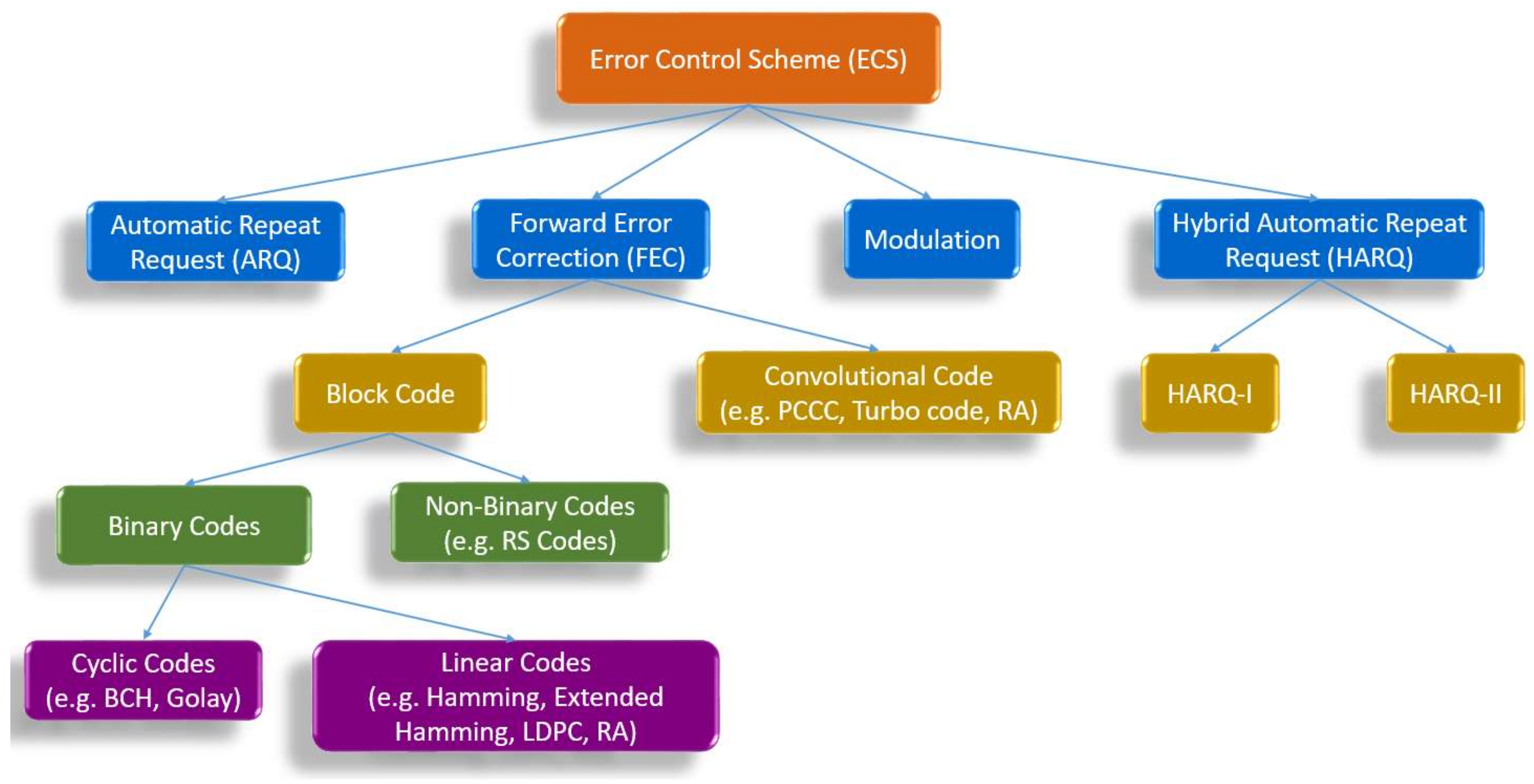

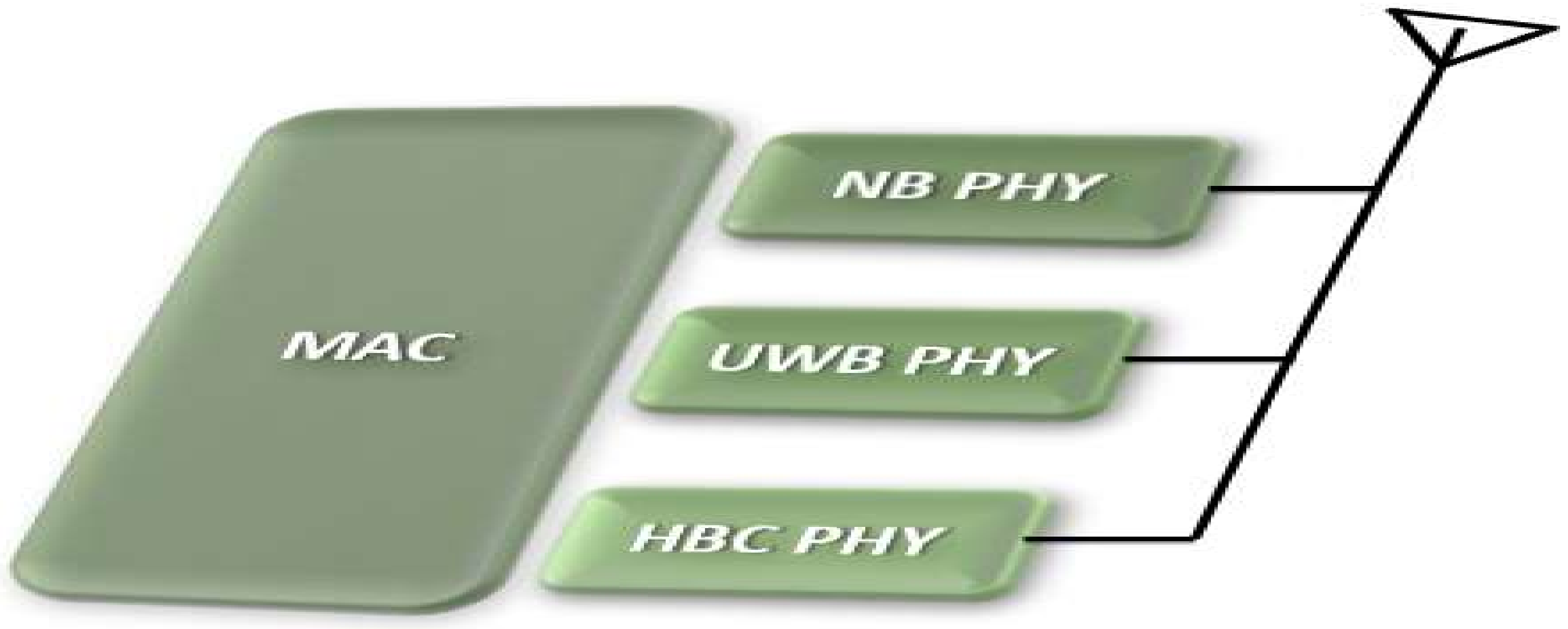
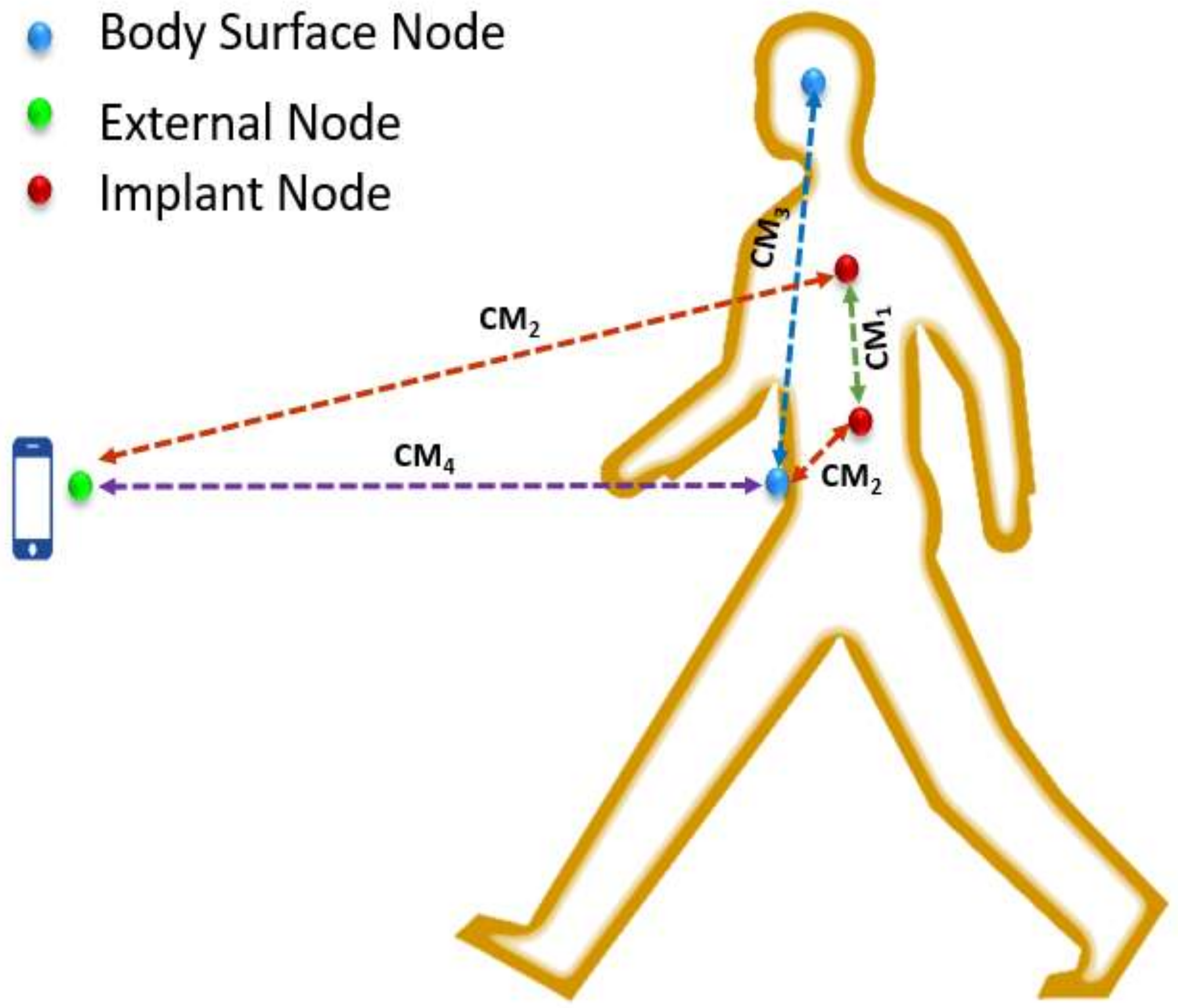
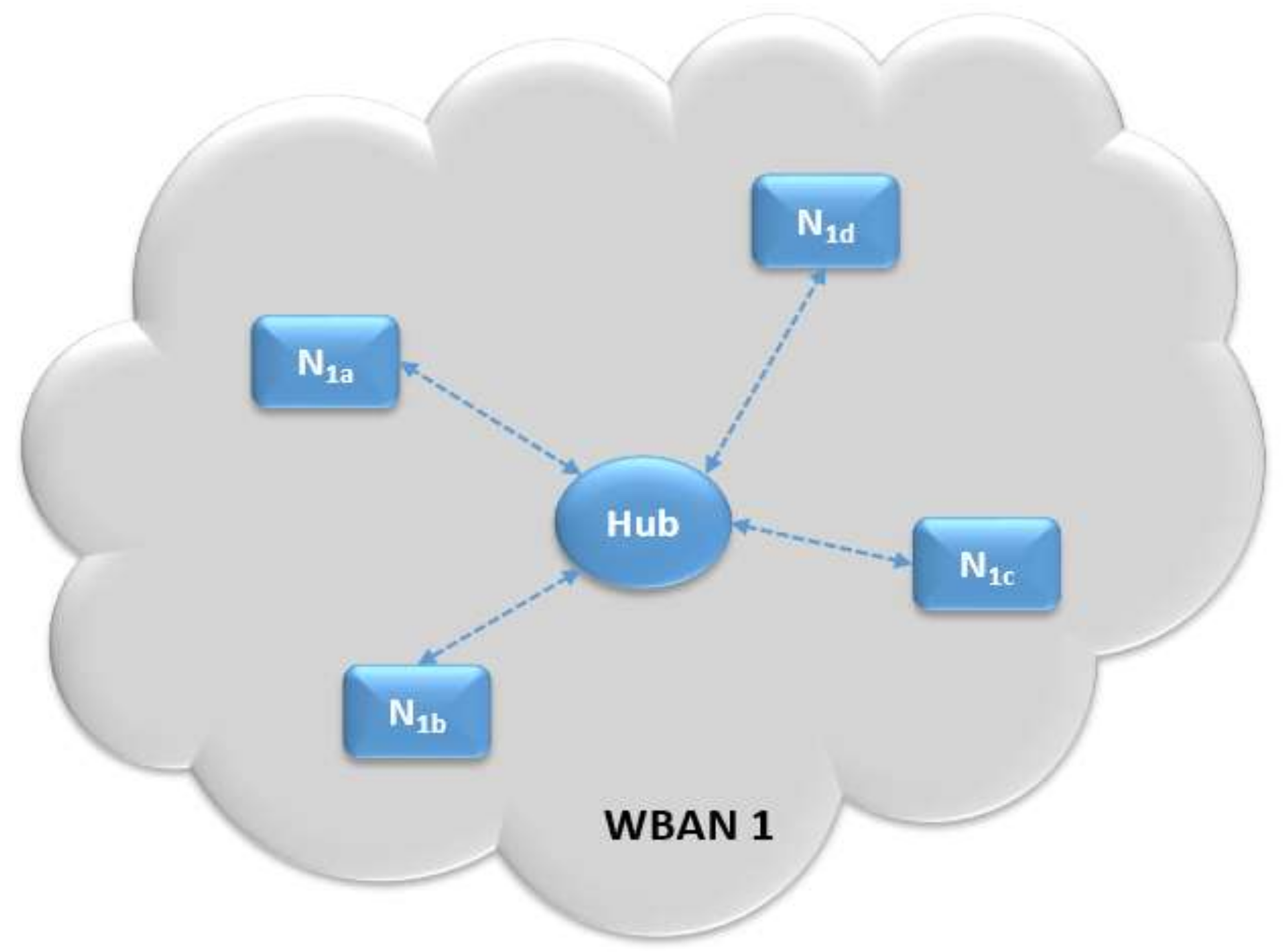
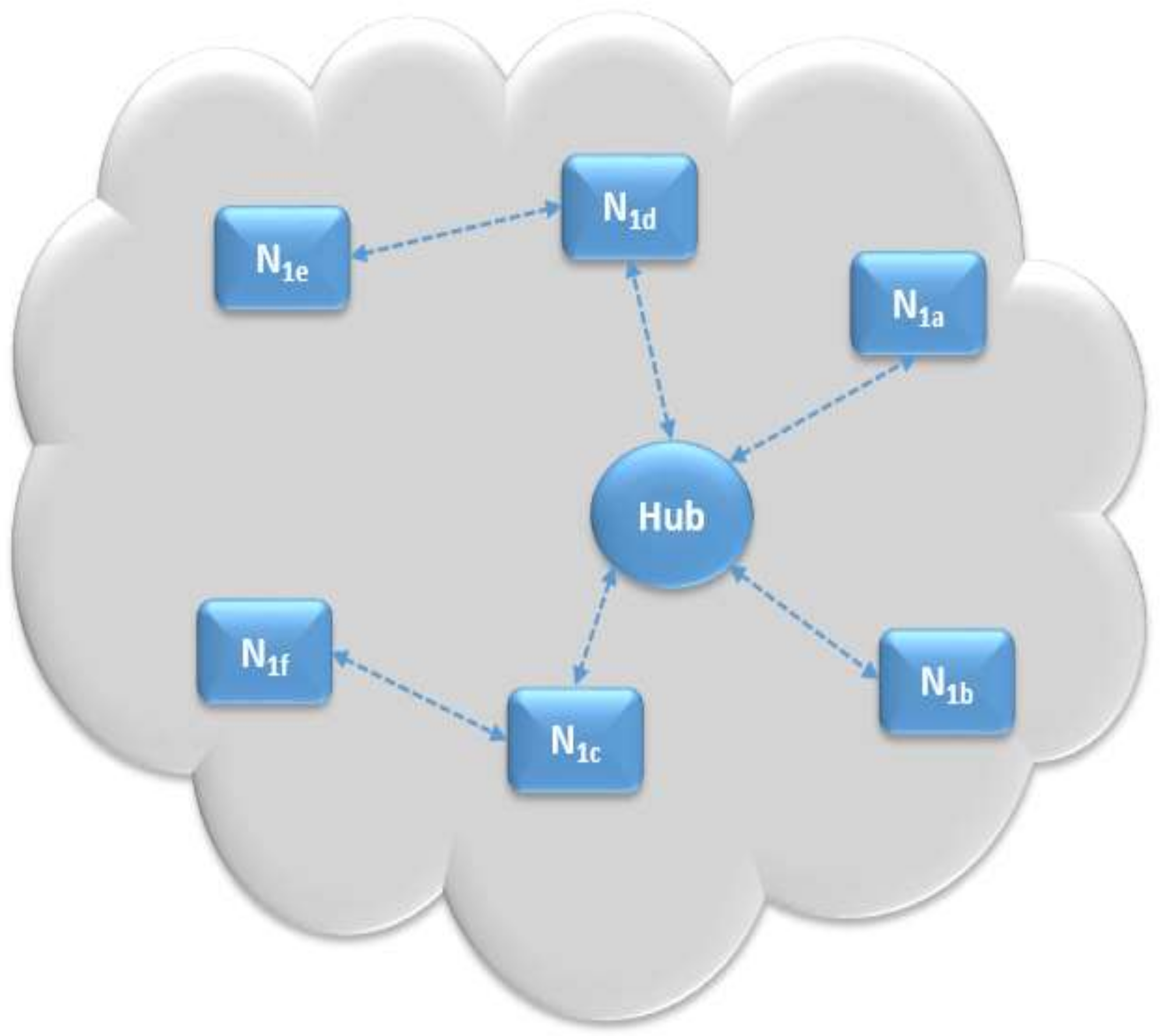
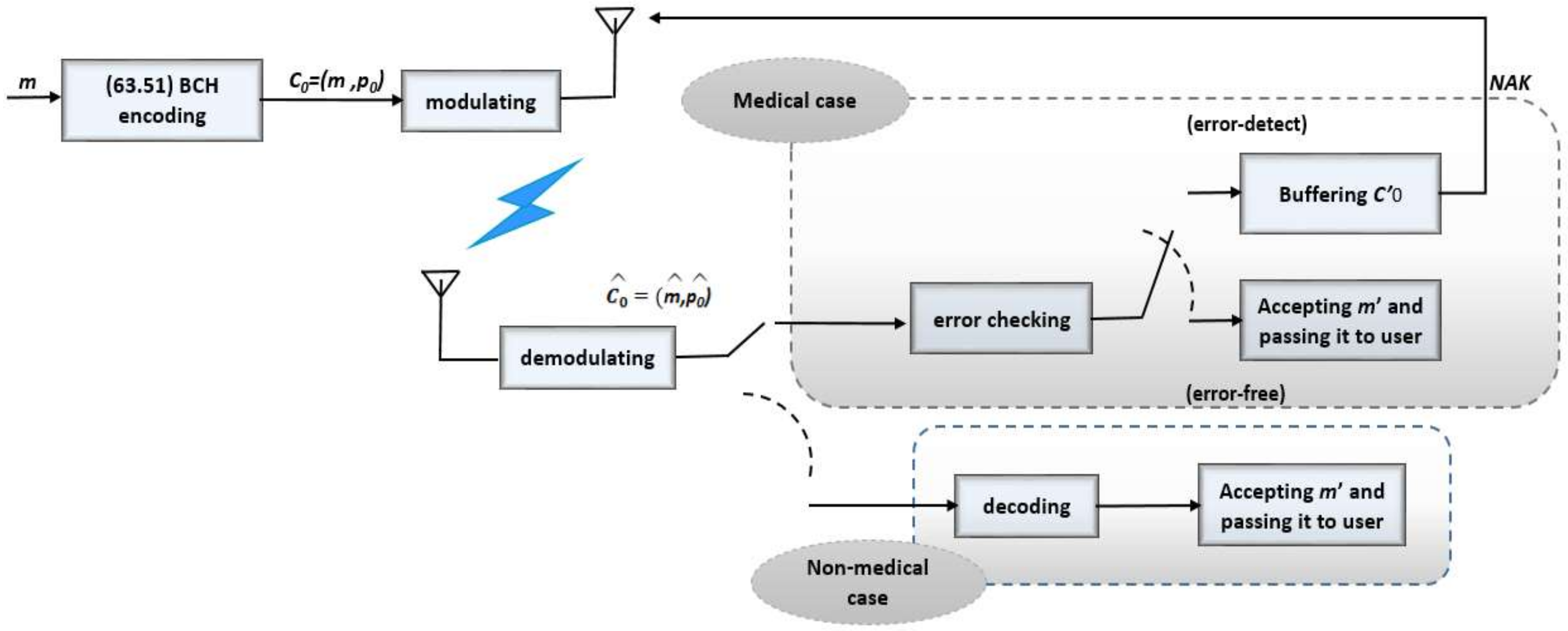
| Priority | User Priority | Traffic Designation | Frame Type |
|---|---|---|---|
| Lowest | 0 | Background (BK) | Data |
 | 1 | Best Effort (BE) | Data |
| 2 | Excellent Effort (EE) | Data | |
| 3 | Video (VI) | Data | |
| 4 | Voice (VO) | Data | |
| 5 | Medical or network control | Data or management | |
| 6 | High-priority medical data or network control | Data or management | |
| Highest | 7 | Emergency or medical implant event report | Data |
| Modulation/Error Correction Technique | Default Mode | High QoS Mode |
|---|---|---|
| Modulation | Mandatory: on-off keying Option: DPSK | Mandatory: DPSK Option: on-off keying |
| FEC | (63,51) BCH code | (126,63) Shortened BCH code |
| HARQ | Not use | Use |
| Scenario | Description | Frequency Band | Channel Model |
|---|---|---|---|
| S1 | Implant to Implant | 402–405 MHz | CM1 |
| S2 | Implant to Body Surface | 402–405 MHz | CM2 |
| S3 | Implant to External | 402–405 MHz | CM2 |
| S4 | Body Surface to Body Surface (LOS) | 13.5, 50, 400, 600, 900 MHz 2.4, 3.1–10.6 GHz | CM3 |
| S5 | Body Surface to Body Surface (NLOS) | 13.5, 50, 400, 600, 900 MHz 2.4, 3.1–10.6 GHz | CM3 |
| S6 | Body Surface to External (LOS) | 900 MHz 2.4, 3.1–10.6 GHz | CM4 |
| S7 | Body Surface to External (NLOS) | 900 MHz 2.4, 3.1–10.6 GHz | CM4 |
| OSI Layer | ECS Methods | |
|---|---|---|
| PHY | FEC and modulation | Cross layer: ARQ, HARQ, FEC/ARQ/HARQ combined with access control mechanism |
| MAC | FEC applied to MAC | |
| Ref. (Yr) | Proposed FEC | WBAN/Standard/Layer/Data/Channel | Results |
|---|---|---|---|
| [33] (010) | LT | One hop star network and single WBAN/IEEE 802.15.6 Task Group/PHY/no discussion/erasure | Packet erasure ratio, retransmission probability |
| [34] (012) | LT | One hop star network and single WBAN/IEEE 802.15.6 Task Group/PHY/no discussion/erasure | PER, retransmission probability and throughput LT and RS codes |
| [35] (016) | RS, convolutional code and Concatenated code | One hop star network and single WBAN/IEEE 802.15.6/PHY/medical and non-medical/AWGN, Rayleigh and Rician fading | BER and coding gain |
| [36] (015) | LT | One hop star network and single WBAN/IEEE 802.15.6/PHY/no discussion/channel adapted from [41,44,45] | BER, coding gain and packet acceptance rate |
| [37] (013) | RS | One hop star network and single WBAN/IEEE 802.15.6/MAC/no discussion/AWGN and fading | BER |
| [39,40] (017, 018) | Raptor code | One hop star network and single WBAN/IEEE 802.15.6/PHY/no discussion/Nakagami, Rayleigh and Rician | Energy consumption |
| [41] (016) | Linear block code | Two hop star network and single WBAN/no discussion/PHY/no discussion/Rayleigh and Rician | BER |
| [42] | LDPC with modified WBF | One hop star network and single WBAN/IEEE 802.15.6/PHY/no discussion/Implant to implant | BER, and no of iterations |
| [43] (018) | Adaptive convolutional code | One hop star network and single WBAN/IEEE 802.15.6/PHY/medical and non-medical/AWGN and Rayleigh | Theoretical bit error probability |
| Ref. (Yr) | Proposed Technique | WBAN/Standard/Layer/Data/Channel | Results |
|---|---|---|---|
| [46] (010) | Adaptive convolutional code with ARQ | One hop star network and single WBAN/IEEE 802.15.6/Cross layer/no discussion/AWGN | MAE and rate of increase of frequency band |
| [47] (016) | BCH with adaptive ARQ | One hop star network and single WBAN/IEEE 802.15.6/Cross layer/NA/AWGN | Energy consumption and delivery ratio |
| Ref. (Yr) | Proposed Technique | WBAN/Standard/Layer/Data/Channel | Results |
|---|---|---|---|
| [48] (010) | BCH code with selective ARQ | One hop star network and single WBAN/IEEE 802.15.6/Cross layer/medical and non-medical/CM3 (on-body to on-body) | Accepting frame error rate, buffer usage and throughput efficiency |
| [49] (013) | Reed-Muller code with Weldon’ s ARQ | One hop star network and single WBAN/IEEE 802.15.6/Cross layer/medical and non-medical/CM3 (on-body to on-body) | Residual BER and throughput |
| [50] (013) | Convolutional code with Weldon’ s ARQ | One hop star network and single WBAN/IEEE 802.15.6/Cross layer/medical and non-medical/AWGN | Residual BER and throughput |
| [51,52] (015) | Convolutional code with Weldon’ s ARQ | One hop star network with multiple WBANs/IEEE 802.15.6/Cross layer/medical and non-medical/AWGN | Residual BER and throughput |
| [52] (015) | Convolutional code with Weldon’ s ARQ | One hop star network and single WBAN/IEEE 802.15.6/Cross layer/medical and non-medical/AWGN | Residual BER, throughput and energy efficiency |
| [53] (016) | Convolutional code with Weldon’s ARQ | Multihop star network and single WBAN/IEEE 802.15.6/Cross layer/medical and non-medical/AWGN | PER, energy efficiency and average number of transmission |
| [54] (017) | Convolutional code with Weldon’ s ARQ | One hop star network and single WBAN/IEEE 802.15.6/Cross layer with different access techniques/medical and non-medical/AWGN | Average number of transmission and probability of unsuccessful transmission |
| [55] (016) | Convolutional code with Weldon’ s ARQ | One hop star network and single WBAN/IEEE 802.15.6/Cross layer/medical and non-medical/AWGN, Rayleigh | Bit error probability, PER, throughput, residual BER, |
| Ref. (Yr) | Proposed Technique | WBAN/Standard/Layer/Data/Channel | Results |
|---|---|---|---|
| [58] (010) | Modulation order (O-QPSK, 2,4,8-DPSK) according to link | One hop star network (considering SNR and SIR)/IEEE 802.15.4/PHY/no discussion/AWGN | PER |
| [60] (012) | Modulation order (O-QPSK, 2,4,8,16-DPSK) according to link | One hop star network (considering SNR)/IEEE 802.15.4/PHY/no discussion/AWGN | PER |
© 2018 by the authors. Licensee MDPI, Basel, Switzerland. This article is an open access article distributed under the terms and conditions of the Creative Commons Attribution (CC BY) license (http://creativecommons.org/licenses/by/4.0/).
Share and Cite
Kadel, R.; Islam, N.; Ahmed, K.; Halder, S.J. Opportunities and Challenges for Error Correction Scheme for Wireless Body Area Network—A Survey. J. Sens. Actuator Netw. 2019, 8, 1. https://doi.org/10.3390/jsan8010001
Kadel R, Islam N, Ahmed K, Halder SJ. Opportunities and Challenges for Error Correction Scheme for Wireless Body Area Network—A Survey. Journal of Sensor and Actuator Networks. 2019; 8(1):1. https://doi.org/10.3390/jsan8010001
Chicago/Turabian StyleKadel, Rajan, Nahina Islam, Khandakar Ahmed, and Sharly J. Halder. 2019. "Opportunities and Challenges for Error Correction Scheme for Wireless Body Area Network—A Survey" Journal of Sensor and Actuator Networks 8, no. 1: 1. https://doi.org/10.3390/jsan8010001
APA StyleKadel, R., Islam, N., Ahmed, K., & Halder, S. J. (2019). Opportunities and Challenges for Error Correction Scheme for Wireless Body Area Network—A Survey. Journal of Sensor and Actuator Networks, 8(1), 1. https://doi.org/10.3390/jsan8010001








